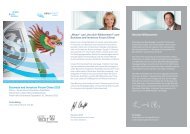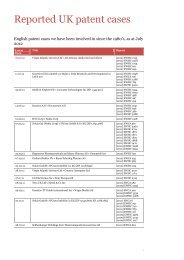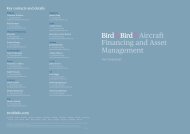Here - Bird & Bird
Here - Bird & Bird
Here - Bird & Bird
You also want an ePaper? Increase the reach of your titles
YUMPU automatically turns print PDFs into web optimized ePapers that Google loves.
554 European Intellectual Property Review<br />
<strong>Here</strong> Come The Boys and its forthcoming tour either were<br />
the Chippendales, or were somehow connected in the<br />
course of trade with, the Chippendales or the<br />
Chippendales’ business. For example references appeared<br />
in the press and other media such as “The Chippendales<br />
are back” or describing the <strong>Here</strong> Come the Boys dance<br />
group as being “re-united” and “re-branded”.<br />
The Chippendales alleged infringement under<br />
art.9(1)(a), 9(1)(b) and 9(1)(c). In relation to art.9(1)(c),<br />
before launching its business, Superstar had no reputation<br />
or goodwill in relation to men’s dance shows. The<br />
Chippendales alleged that, had Superstar launched its<br />
business without using the CHIPPENDALES name, it<br />
would have had to spend a great deal more time, effort<br />
and money on promoting and advertising its business to<br />
bring it to the attention of its target customers and for<br />
example to secure bookings at theatre venues. By relying<br />
on the Chippendales’ reputation and goodwill in the<br />
Chippendales’ business, it was alleged that Superstar had<br />
attracted the Chippendales’ customers and potential<br />
customers to itself, thereby taking unfair advantage of<br />
the reputation and distinctiveness of the<br />
CHIPPENDALES trade mark.<br />
An interesting aspect of this case is that it is possible<br />
that not all the customers and potential customers of the<br />
group <strong>Here</strong> Come the Boys were necessarily confused in<br />
that they may have been (or become) aware that the group,<br />
although containing former Chippendales, was not, and<br />
was not connected to, the presently performing<br />
Chippendales. However, the motivation of the audience<br />
to attend the performance by <strong>Here</strong> Come The Boys would<br />
in most if not all cases have been primarily because of<br />
the link with the iconic brand the Chippendales who<br />
alleged that Superstar intended to use the Chippendales<br />
name to take advantage of the famous brand name. In<br />
line with the Whirlpool and Specsavers cases, such<br />
intention would make the advantage unfair.<br />
Like the L’Oréal case itself this case also raises<br />
questions of legitimate descriptive use in the light of the<br />
former Chippendales performers, although, following the<br />
CJEU’s reasoning, the use of the mark was as in L’Oréal<br />
not for purely descriptive purposes, but use which might<br />
affect the communication, investment and advertising<br />
functions of the mark.<br />
How should European trade mark law<br />
develop?<br />
In the United Kingdom art.5(2)/9(1)(c) was originally<br />
implemented into law in such a way as to preclude<br />
protection under that heading for identical or similar<br />
goods. Thus the three categories of infringement<br />
corresponding to art.9(1)(a), 9(1)(b) and 9(1)(c) did not<br />
involve an overlap. Article 9(1)(a) dealt with cases of<br />
“double identity” (identical signs and identical goods/<br />
services). In such a case infringement may be established<br />
15 Adidas Salomon v Fitnessworld (C-408/01) [2003] E.C.R. I-12537; [2004] 1 C.M.L.R. 14.<br />
16 Davidoff & Cie v Gofkid Ltd (C-292/00) [2003] E.C.R. I-389; [2003] E.T.M.R. 42.<br />
17 Baywatch Productions Co Inc v The Home Video Channel [1997] F.S.R. 22 Ch D.<br />
without the need to show confusion or a likelihood of<br />
confusion (although such confusion will be the inevitable<br />
result in most cases where use has occurred). Article<br />
9(1)(b) dealt with identical or similar signs and<br />
identical/similar goods/services. In such cases<br />
infringement required a showing of a likelihood of<br />
confusion or association. Article 9(1)(c) dealt with<br />
identical/similar signs and dissimilar goods/services, and<br />
required a trade mark with a reputation in the Community,<br />
use without due cause and the taking unfair advantage<br />
of, or detriment to the distinctive character or repute of<br />
the CTM. As discussed below it was confirmed by the<br />
CJEU that a likelihood of confusion or association is not<br />
required under the third category of infringement.<br />
Following the Opinion of the Advocate General in<br />
Adidas Salomon v Fitnessworld (C-408/01), 15 followed<br />
by the ECJ in that case and in Davidoff II, 16 it was held<br />
that art.5(2)/9(1)(c) could and should equally apply to<br />
identical or similar goods/services, disregarding the literal<br />
words of that article. In part this was in response to the<br />
curtailment of art.5(2) by national courts (such as the<br />
English High Court in Baywatch Productions Co Inc v<br />
The Home Video Channel 17 which had held that this form<br />
of infringement also required confusion), on the reasoning<br />
that it would be illogical for non-similar goods to be<br />
accorded greater protection than similar goods by<br />
dispensing with the ingredient of the likelihood of<br />
confusion. The ECJ held that the protection accorded by<br />
art.5(2) to marks with a reputation was not conditional<br />
on a finding that there existed a likelihood of confusion.<br />
As a result the United Kingdom also amended its law to<br />
delete the reference to non-similar goods, thus extending<br />
the protection of art.5(2)/9(1)(c) to identical and similar<br />
goods/ services. The Max Planck Study has recommended<br />
at para.2.197 that art.9(1)(c) should likewise be changed<br />
to express the principle that protection is granted<br />
irrespective of whether the sign is used for identical,<br />
similar or dissimilar goods.<br />
With hindsight, the extension of art.9(1)(c) to identical<br />
and similar goods/services can be seen as the reason for<br />
the current unease about the unclear extent of protection<br />
accorded by it. The original framework involved<br />
non-overlapping categories: art.9(1)(b) was to apply to<br />
similar goods/services where there exists a likelihood of<br />
confusion, and art.9(1)(c) was intended to apply to<br />
non-similar goods/services where there is a trade mark<br />
with a reputation and unfair advantage or detriment to<br />
distinctive character or repute (but with no need to show<br />
confusion). In other words if the goods/services were<br />
identical or similar it should be possible for the trade mark<br />
owner to establish confusion and there would be no need<br />
for the type of extended protection accorded under<br />
art.9(1)(c). If the trade mark owner cannot establish such<br />
confusion in the case of identical or similar<br />
goods/services (such that the essential function of the<br />
trade mark as a guarantee of origin is not liable to be<br />
[2011] E.I.P.R., Issue 9 © 2011 Thomson Reuters (Professional) UK Limited and Contributors








